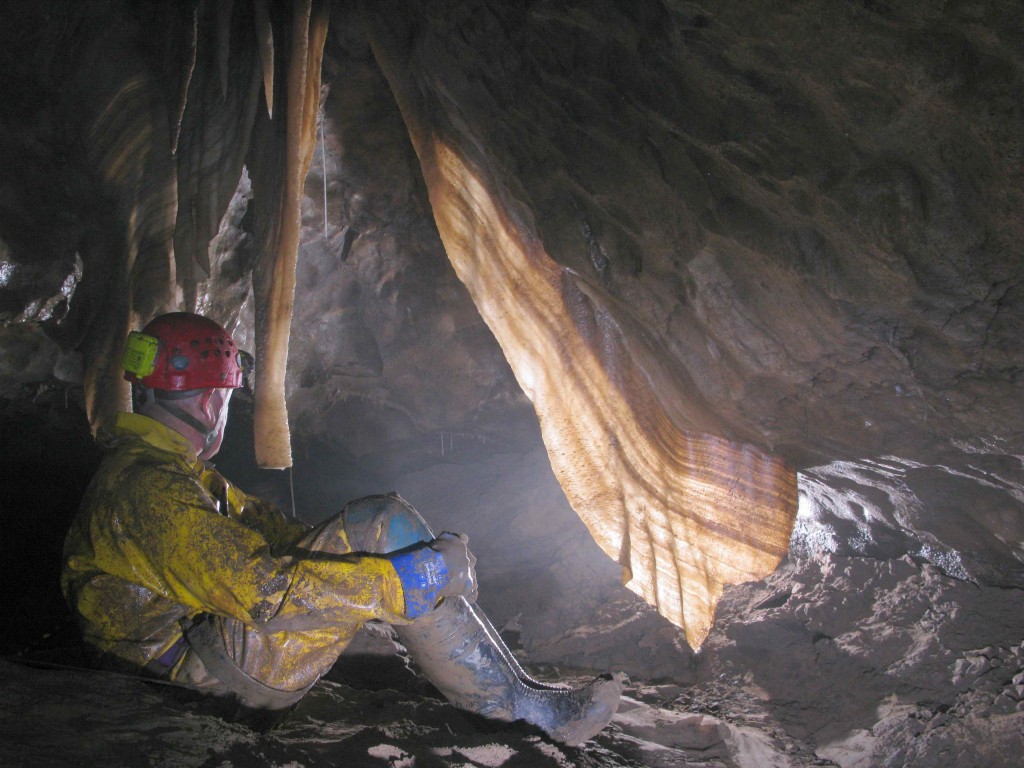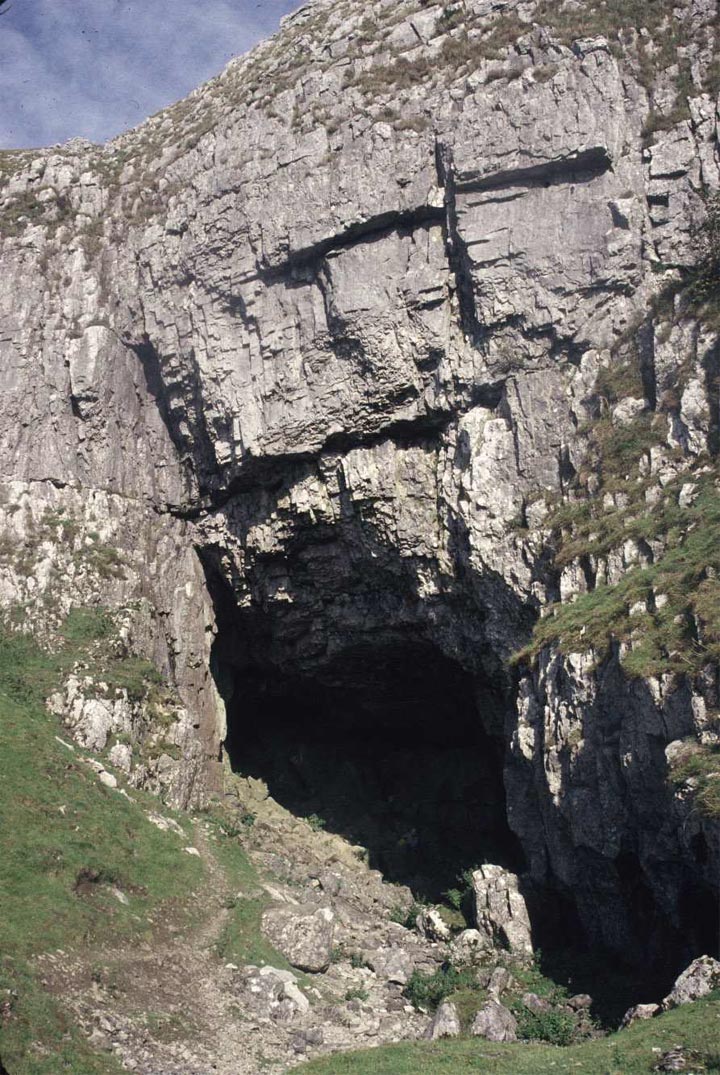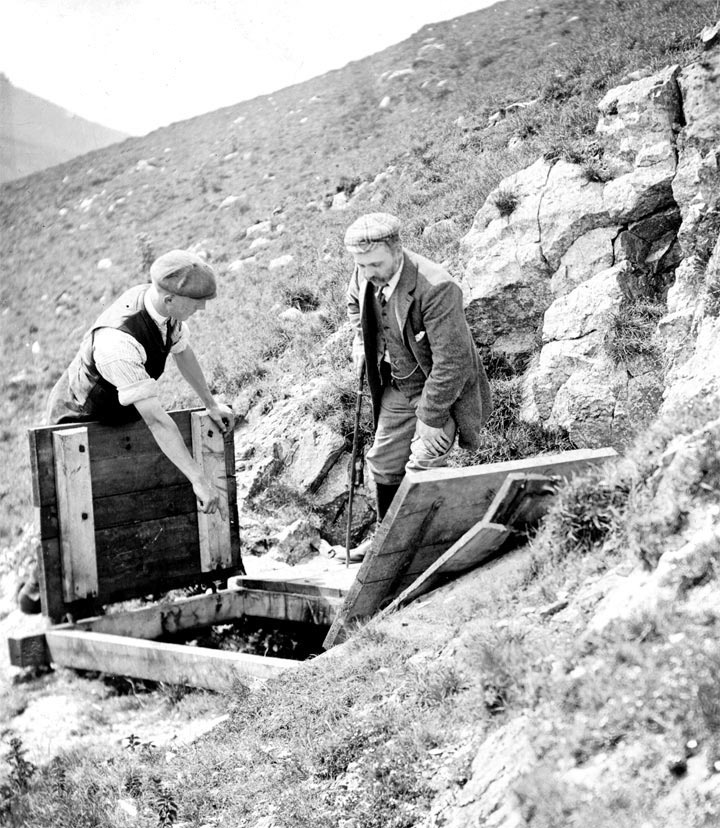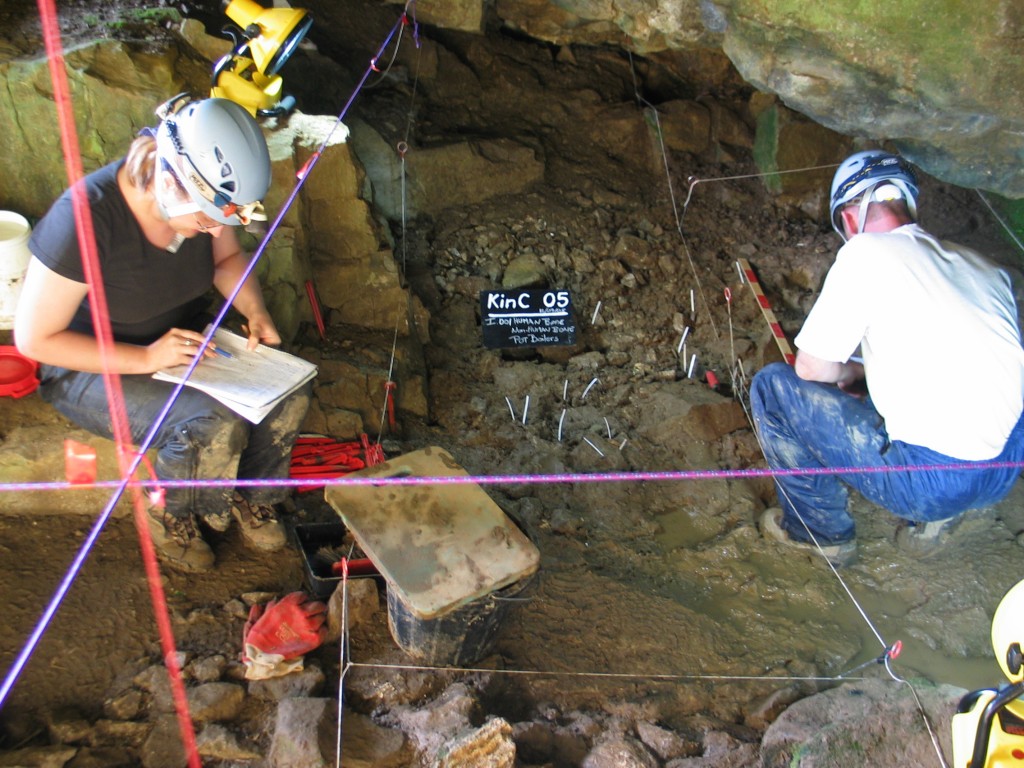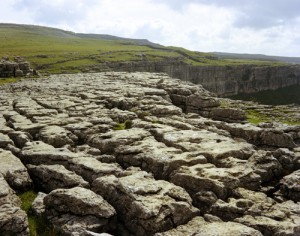Kinsey Cave is a scheduled ancient monument, situated north of Settle and Giggleswick on High Scar above the 300-metre contour. It was excavated sporadically from the 1880s onwards, with major work taking place under the direction of J Wilfred Jackson and W Kinsey Mattinson between 1925 – 1931.
A carved reindeer antler tang and five chipped stone tools dating to the end of the Ice Age approximately 13,000 years ago were recovered from the cave environs, although their exact find location was not detailed in the records.
On this basis, the cave was scheduled in 1949. In addition, significant quantities of Roman artefacts of cultic appearance were recovered from the upper layers of the cave, including perforated bone spoons and round pieces of perforated pottery, as well as items of dress jewellery. Romano-British deposits of this type are known from a number of Dales caves, including Victoria, Attermire, and Sewells – seeming to indicate that Roman cults utilised the caves for rituals. This was a well-known practice for many of the Roman auxiliary troops stationed in the north, such as Dalmatians, Sarmatians and Dacians, who would have identified the rocky terrain as similar to the Karst landscapes of their homeland in southeast Europe.
Faced with a lack of stratigraphic control and detailed publication records from the original excavation, the first step for the project was a comprehensive assessment of the existing archive.

What followed was an analytical integration of the Kinsey Cave archive, with 22 new high-resolution dates from human bones and domestic and wild animals. Beyond the cave mouth, a programme of remote sensing was used to identify the spoil heaps and any potential voiding within the talus slope (the area of debris and scree outside the cave mouth). This helped direct the new excavation strategy, with three-dimensional recording of all recently exposed bone and 100% sampling of all disturbed sediments. By establishing a micro-excavation of badger movements, determining the integrity of the remaining cave sediment and the main areas of damage, the team could report to English Heritage and English Nature with recommendations for the cave’s future management.
The Kinsey Report
Despite the large preponderance of Romano-British artefacts in the site archive, the cave had been seen as a predominantly Palaeolithic site on the basis of lithic and worked antler material, and associated animal bone from long extinct species. A reassessment of the archive material, though, casts doubt on this, challenging the earlier assumptions that the cave contained intact Palaeolithic archaeology. Mattinson and Jackson, the original excavators, had recorded their finds in a number of illustrated notebooks, attributing human bones to a catchall ‘bear horizon.’ Given the associations of animal bone from ‘ancient’ wild species such as bear and lynx, they assumed that the cave was used in the immediate post-glacial period for human burial – an interpretation supported by the carved antler and lithic artefacts.

By taking a distribution of 22 radiocarbon dates in the existing cave archive, cross-referenced with the new excavation, the team established that rather than originating from one single phase of activity, the ‘bear horizon’ excavated by Mattinson and Jackson contained material dating to three main phases separated by over 10,000 years. The earliest dated evidence was from a brown bear specimen dating to 12,500 BC, but this predated evidence for humans by at least 1,000 years. A carved reindeer antler tang found during Mattinson’s excavations inside the cave dated to 11,400 BC, corresponding to chipped stone tools that date to this time, and likely to have been found after the excavation on the slope outside the cave.
This demonstrates that the cave may well have been a significant site to late glacial hunters, but the most important result came from dating the human bone. This was expected to be Palaeolithic, but in fact dated to between 3960-3790 BC, making it some of the earliest Neolithic material dated in this part of the Dales. Rather than late glacial hunter burials, these could plausibly be viewed as part of the founder population of incoming farmers. During the Mesolithic/Neolithic interface similar remains were deposited at sites like Gough’s Cave in the Cheddar Gorge, Somerset, associated with complex cannibalistic burial rites. Green bone processing, curation and secondary burial are known from contemporary sites, and these dates point the way towards research into similar practices in the upland cave archive.
 A further surprise for the excavators was that the cave produced the latest recoded date for wild lynx in the British Isles, placing the animal’s extinction around AD 425-600. This has significant implications for our understanding of the landscape, and the part humans have played in shaping it. Until recently, it was believed the Eurasian lynx was believed to have become extinct when the climate became cool and wet around 4,000 years ago. Eurasian Lynx depend on a habitat with at least 40% tree cover, and the presence of large predators suggests a wild landscape, artificially maintained as a ‘wild forest’ during the early medieval period.
A further surprise for the excavators was that the cave produced the latest recoded date for wild lynx in the British Isles, placing the animal’s extinction around AD 425-600. This has significant implications for our understanding of the landscape, and the part humans have played in shaping it. Until recently, it was believed the Eurasian lynx was believed to have become extinct when the climate became cool and wet around 4,000 years ago. Eurasian Lynx depend on a habitat with at least 40% tree cover, and the presence of large predators suggests a wild landscape, artificially maintained as a ‘wild forest’ during the early medieval period.
Once this land was brought back into cultivation, the lynx was then driven into extinction. This has important implications for modern zoology, and the reintroduction of wild species into the contemporary landscape. The European Union’s Habitats Directive obliges member states to consider reintroducing a species that have been killed off by human action. If the National Park committee applies the results from Kinsey Cave literally, ramblers in the Dales might soon find their pace quicken!
The Upland Cave Network
The Kinsey Cave investigation results demonstrated the great benefits of target excavation coupled with scientific analysis of existing archives. The remains disturbed by badgers in 2005 were shown to come from small pockets of remaining archaeology within a cave that had, for all intents and purposes, been emptied of its archaeological fill. If, however, the Victorian and 20th century ‘cave hunters’ have cleared out many of the more accessible and larger caves in the limestone uplands, real opportunity still exists for archaeological investigation in caves that are harder to access.

A growing number of reports of animal bone finds by cavers working in smaller caves and potholes led to the realisation that greater collaboration was needed between cavers and archaeologists. This led to the creation of ‘The Upland Cave Network’ – a group run by Dr Hannah O’Regan from Liverpool John Moores University bringing together cavers, geologists, archaeologists, palaeontologists and others interested in archaeological aspects of northern caves. Funded by the Arts and Humanities Research Council, the group has hosted seminars to present recent work and develop guidelines for excavating and conserving caves in future. Additionally, by putting cavers in touch with local archaeologists and other experts, the group fosters communication so that anything of interest discovered during cave exploration can be properly assessed and understood. This has been so successful that Dr O’Regan and John Howard have set up a special cave archaeology group under the umbrella of the British Cave Research Association. There have been many examples of cavers in the Yorkshire/Lancashire area coming forward with new discoveries, but the best case so far was ‘Shuttleworth Pot into Witches Cave II’ published this summer by the Council for Northern Caving Clubs.
And that is the subject of the concluding part 3 – read more here…
Or download the full article here…

